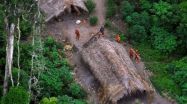(Press-News.org) The shale gas boom has transformed the energy landscape in the U.S., but in some drier locations, it could cause conflict among the energy industry, residents and agricultural interests over already-scarce water resources, say researchers. They add that degraded water quality is a potential risk unless there are adequate safeguards. The feature article appears in the ACS journal Environmental Science & Technology.
Meagan S. Mauter and colleagues point out that a major criticism of extracting shale gas through hydraulic fracturing, or "fracking," is that it requires tremendous amounts of water — 2.5 to 5 million gallons — to develop a single well. Water, along with chemicals and sand, is injected under high pressure into wells to create cracks, or fractures, in shale and release stored gas. In some water-rich places, such as Pennsylvania, this is not a significant problem. But in other locations, including some rural counties in arid south Texas, this level of water use competes with residential and agricultural needs and depletes groundwater resources. These and other types of region-specific scenarios are similar to what other states and countries could encounter when or if they also develop shale gas reserves. Mauter's team looked at what practices could help maintain a balance between fracking and environmental and residential needs.
The researchers say that there are ways to minimize the industry's water footprint. One method is to use brackish water that is not fit for drinking or agricultural use but can be suitable for fracking. The other method is to recycle the waste water. "Leadership from both industry and the U.S. government may be needed to assure that economic benefits of shale gas development are realized without significant regional impairment of water resource quantity and quality," the authors conclude.
The American Chemical Society is a nonprofit organization chartered by the U.S. Congress. With more than 161,000 members, ACS is the world's largest scientific society and a global leader in providing access to chemistry-related research through its multiple databases, peer-reviewed journals and scientific conferences. Its main offices are in Washington, D.C., and Columbus, Ohio.
To automatically receive news releases from the American Chemical Society, contact newsroom@acs.org.
Follow us: Twitter | Facebook
INFORMATION: END
How to avoid water wars between 'fracking' industry and residents
2014-04-23
ELSE PRESS RELEASES FROM THIS DATE:
RI Hospital physician: Legalizing medical marijuana doesn't increase use among adolescents
2014-04-23
PROVIDENCE, R.I. – Parents and physicians concerned about an increase in adolescents' marijuana use following the legalization of medical marijuana can breathe a sigh of relief. According to a new study at Rhode Island Hospital which compared 20 years worth of data from states with and without medical marijuana laws, legalizing the drug did not lead to increased use among adolescents. The study is published online in advance of print in the Journal of Adolescent Health.
"Any time a state considers legalizing medical marijuana, there are concerns from the public about ...
In lab tests, the antimicrobial ingredient triclosan spurs growth of breast cancer cells
2014-04-23
Some manufacturers are turning away from using triclosan as an antimicrobial ingredient in soaps, toothpastes and other products over health concerns. And now scientists are reporting new evidence that appears to support these worries. Their study, published in the ACS journal Chemical Research in Toxicology, found that triclosan, as well as another commercial substance called octylphenol, promoted the growth of human breast cancer cells in lab dishes and breast cancer tumors in mice.
Kyung-Chul Choi and colleagues note that hormonal imbalances seem to play a role in ...
Male-biased tweeting
2014-04-23
This news release is available in German. It all started out with a comic strip in 1985. A cartoon character explained to her female companion which three requirements a movie had to fulfil for her to want to watch it: (one) it has to have at least two women in it (two) who talk to each other about (three) something besides a man. Born was the Bechdel test, named after American cartoonist Alison Bechdel. The test reveals whether a movie features a minimum of female independence.
A lot of Hollywood movies fail the Bechdel test miserably. That movies like "Star Wars" ...
Female intuition could be linked to lower exposure to testosterone in women while in womb
2014-04-23
This news release is available in Spanish.
So-called "female intuition" could actually have a biological component, related to the lower prenatal exposure to testosterone women receive in the womb. This would lead them to have a "more intuitive and less reflective" attitude to life than men. These are the results of a study carried out by Spanish researchers from the University of Granada, the Barcelona Pompeu Fabra University and the Middlesex University of London, in an article recently published in the journal Psychoneuroendocrinology.
According to previous ...
Steering chemical reactions with laser pulses
2014-04-23
Usually, chemical reactions just take their course, much like a ball rolling downhill. However, it is also possible to deliberately control chemical reactions: at the Vienna University of Technology, molecules are hit with femtosecond laser pulses, changing the distribution of electrons in the molecule. This interaction is so short that at first it does not have any discernable influence on the atomic nuclei, which have much more mass than the electrons. However, the disturbance of the electron distribution can still initiate chemical processes and eventually separate ...
Uniting community development efforts could benefit members of underserved communities
2014-04-23
COLUMBIA, Mo. –Research shows that wealth inequality creates barriers to community development, due to the widespread effects of poverty. A report by the United Nations Children's Fund shows that more than one in five children in the United States falls below the poverty line. Although many organizations address poverty, they often serve similar demographics and may compete for clients and resources. Recently, University of Missouri researchers studied Cooperative Extension's efforts to link community development organizations and concluded Extension is the hub that can ...
Remote surveillance may increase chance of survival for 'uncontacted' Brazilian tribes
2014-04-23
COLUMBIA, Mo. – Lowland South America, including the Amazon Basin, harbors most of the last indigenous societies that have limited contact with the outside world. Studying these tribes, located deep within Amazonian rainforests, gives scientists a glimpse at what tribal cultures may have been like before the arrival of Europeans. Now, researchers at the University of Missouri have used satellite images to assess the demographic health of one particular village of isolated people on the border between Brazil and Peru. Remote surveillance is the only method to safely track ...
Impact of whooping cough vaccination revealed
2014-04-23
The most comprehensive study to date of the family of bacteria that causes whooping cough points to more effective vaccine strategies and reveals surprising findings about the bacteria's origin and evolution. The new results could alter public health strategies to control this respiratory disease, which kills 195,000 children worldwide each year.
Genomic analysis of 343 strains of the Bordetella pertussis bacteria from around the world collected over the last 100 years illustrates how vaccination has shaped its evolution. Since its introduction across the globe between ...
Loss of memory in Alzheimer's mice models reversed through gene therapy
2014-04-23
Alzheimer's disease is the first cause of dementia and affects some 400,000 people in Spain alone. However, no effective cure has yet been found. One of the reasons for this is the lack of knowledge on the cellular mechanisms which cause alterations in nerve transmissions and the loss of memory in the initial stages of the disease.
Researchers from the Institute of Neuroscience at the Universitat Autònoma de Barcelona have discovered the cellular mechanism involved in memory consolidation and were able to develop a gene therapy which reverses the loss of memory in mice ...
Liquid spacetime
2014-04-23
What if spacetime were a kind of fluid? This is the question tackled by theoretical physicists working on quantum gravity by creating models attempting to reconcile gravity and quantum mechanics. Some of these models predict that spacetime at the Planck scale (10-33cm) is no longer continuous – as held by classical physics – but discrete in nature. Just like the solids or fluids we come into contact with every day, which can be seen as made up of atoms and molecules when observed at sufficient resolution. A structure of this kind generally implies, at very high energies, ...



